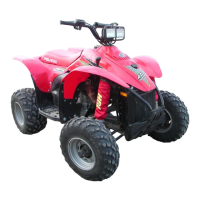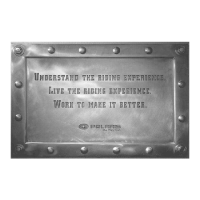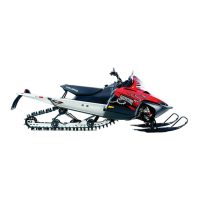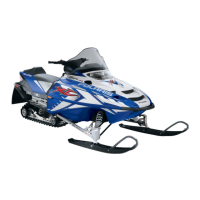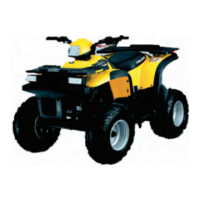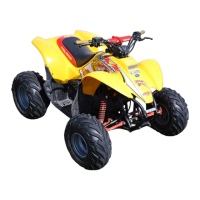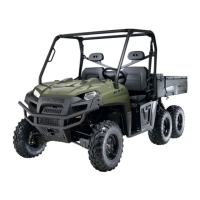What to do if my Polaris 2007 Scrambler 500 4X4 has poor quality or low octane fuel?
- KKelly GilbertSep 3, 2025
If your Polaris Offroad Vehicle has poor quality or low octane fuel, replace it with the recommended fuel.

What to do if my Polaris 2007 Scrambler 500 4X4 has poor quality or low octane fuel?
If your Polaris Offroad Vehicle has poor quality or low octane fuel, replace it with the recommended fuel.
What to do if my Polaris 2007 Scrambler 500 4X4 has loose solenoid connections?
If your Polaris Offroad Vehicle has loose solenoid connections, check all connections and tighten them.
How to fix belt slippage from water or snow ingestion into the PVT system of my Polaris 2007 Scrambler 500 4X4 Offroad Vehicle?
To address belt slippage in your Polaris Offroad Vehicle due to water or snow in the PVT system, shift the transmission to neutral. Then, using the throttle, vary the engine RPM from idle to full throttle, repeating several times as needed. Do not hold the throttle at full position for more than 10 seconds during this process. If the issue persists, inspect clutch seals for damage.
What to do if my Polaris 2007 Scrambler 500 4X4 Offroad Vehicle has a clogged fuel valve or filter?
If your Polaris Offroad Vehicle has a clogged fuel valve or filter, inspect and clean or replace it.
What to do if my Polaris 2007 Scrambler 500 4X4 Offroad Vehicle has a fuel valve turned off?
If the fuel valve of your Polaris Offroad Vehicle is turned off, turn the fuel valve on.
What to do if my Polaris 2007 Scrambler 500 4X4 Offroad Vehicle has old or non-recommended fuel?
If your Polaris Offroad Vehicle has old or non-recommended fuel, replace it with new fuel.
What to do if my Polaris 2007 Scrambler 500 4X4 has loose battery connections?
If your Polaris Offroad Vehicle has loose battery connections, check all connections and tighten them.
What to do if my Polaris Offroad Vehicle has a tripped circuit breaker?
If your Polaris Offroad Vehicle has a tripped circuit breaker, reset the breaker.
What to do if my Polaris 2007 Scrambler 500 4X4 Offroad Vehicle has a clogged fuel filter?
If your Polaris Offroad Vehicle has a clogged fuel filter, replace the filter.
What to do if my Polaris Offroad Vehicle has low battery voltage?
If your Polaris Offroad Vehicle has low battery voltage, recharge the battery to 12.8 VDC.
| Brand | Polaris |
|---|---|
| Model | 2007 Scrambler 500 4X4 |
| Category | Offroad Vehicle |
| Language | English |
Key safety guidelines and precautions for operating the ATV.
Precautions for handling gasoline and engine exhaust fumes safely.
Recommended protective gear including helmet, eye protection, gloves, boots, and clothing.
Explanation of override, main, and engine stop switches.
Operation of the throttle lever and the Electronic Throttle Control (ETC) system.
Details on brake lever, fluid checks, parking brake, and auxiliary brake system.
How to select Forward, Neutral, and Reverse gears.
Operation and engagement of the AWD system for enhanced traction.
Recommended procedures for the first 10 hours of operation for engine longevity.
Checklist of essential checks before each ride to ensure safety.
Step-by-step guide for safely starting the ATV's engine.
Comprehensive guide to safe driving techniques and precautions.
Guidelines on not modifying exhaust components to meet noise regulations.
Schedule for regular inspection, adjustment, and lubrication of vehicle components.
Chart detailing lubrication points, types, and methods.
Procedures for checking and changing engine oil and filter.
Checks for fluid leaks, lever feel, pad wear, and disc condition.
Procedures for wheel removal, installation, and tire tread depth checks.
Maintenance, removal, installation, charging, and storage procedures for the battery.
Tips for washing, polishing, and storing the vehicle properly.
List of recommended Polaris lubricants, coolants, and additives.
Key vehicle capacities including fuel, oil, and coolant volumes.
Technical details of the engine, cooling, ignition, and carburetion.
Clutch settings based on altitude and ambient temperature conditions.
Solutions for common issues related to the drive belt and PVT system.
Diagnosing why the engine cranks but does not start.
Troubleshooting steps for when the engine stops or loses power.
Details of the limited warranty, coverage, and registration requirements.
Specific warranty coverage for emission control components.
A log to record all scheduled maintenance performed on the vehicle.


